The Karakoram Mountain Range
This is the story of a 1600 miles extreme microlight adventure in the Karakoram Mountains (Pakistan). The microlight a David Cook’s designed Shadow Star Streak with a Rotax 912S engine .The flight was to take us through some of the most spectacular landscape and demanding environment in the world. Whether it is the sheer beauty and scale of nature or the violent turbulence, the Karakorams are second to none. Our purpose besides yearning for an
adrenaline pumping adventure was to test the Star Streak’s claimed performance at high altitude as a prelude to further long distance flying in our effort to raise funds for the under privileged children of Pakistan.
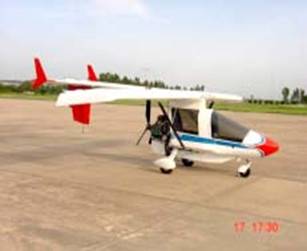 |
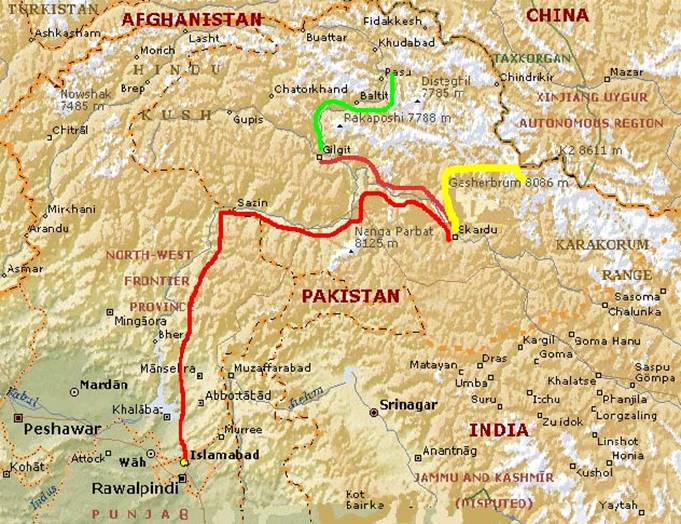 |
The Route. The start point was Islamabad - the Capital city- and then north through the mighty Indus river gorge between the eastern Hindukush and western reaches of Himalayan mountain ranges respectively to the first destination -Skardu, Karakoram’s biggest town (7600 feet AMSL) 324 miles away. Thereafter we were to undertake a series of exploratory flights in the
surrounding valleys, including one over the 40 miles long Baltoro Glacier and a possible flight over the base camp of Mount K-2( 28251 feet) The second stop was to be the town of Gilgit (4800 feet AMSL) 100 miles west of Skardu along the Karakoram highway (old silk route) which crosses into China 550 miles from Islamabad. With Gilgit as the base, our next flight was to be along the Karakoram highway north wards to the Pakistan—Chinese border at Khunjerab pass (15500 feet ) and back an aerial distance of over 300 miles, all through totally unforgiving terrain. The final home bound leg of our journey was to be from Gilgit to Islamabad (270 miles) taking us back down the Indus river gorge.
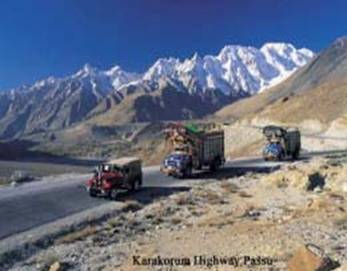 |
Preparations. The microlight aircraft was thoroughly prepared, route and weather studied carefully. There is no second chance in this type of terrain, with that in mind the amount of fuel was carefully calculated to cater for the long climb,but with sufficient reserve to reach safety in case the clouds unexpectedly blocked the valley to Skardu or to the alternative airport Gilgit. Necessary energy boosting refreshments (juice and candies etc) essential for the long flight were stored in the nooks and corners.With two on board the Star Streak doesn’t have spare space. Long distance microlight flying demands exactly that – Very light ! Hence, no Luggage! All spares, clothing etc were dispatched in advance to Skardu and Gilgit.
The Adventure Begins. Although the monsoons had lost their intensity, August is not the best time to fly in the region. Nevertheless due to other professional commitments we were strapped for time and had to go ahead with our plans. We took off from Islamabad (elevation 1600 feet ) at 0640 hours on 26th August 2001 with almost 75 liters of fuel. The Star
Streak climbed sluggishly in the hot air
and 40 minutes later leveled off at 10000 feet ( for fuel economy climb is at 5000 RPM).
 |
The weather report forecasted a visibility of 3 Km with clouds up to 8000 feet initially ,but expected to clear up as we neared the mountains. Flying in the poor visibility and without positive ground contact, Ajab was uncomfortable as even the 4000 feet high hills surrounding Islamabad were hidden from sight upon takeoff. Infact visibility was so poor that, half an hour into the flight an 8500 feet high mountain 5 miles west of our route was nowhere to be seen. To our relief it faintly appeared through the clouds to our west, even though, practically we were still flying blind. The electric attitude gyro proved invaluable, though expensive it was money well spent. As forecasted, the visibility gradually improved 1 hour after take off. Just before entering the Indus river gorge the visibility was CAVOK with the snow capped Hindukush range appearing on our left, the Nanga Parbat Massif (26657 feet) dominating the western Himalayas on our right. Ahead in the far distance silhouetted against the azure sky were the majestic snow-covered spires of Karakorams stretching North West to North East. Cranking up Yanni on the inflight music system added to the enjoyment of such breath taking landscape.
 |
The
though, practically we were still flying ANR headsets, a must in the noisy shadow, match nicely with a walkman for good stereo sound, a luxury on long flights. The ANR headsets, a must in the noisy Shadow, match nicely with a walkman for good stereo sound, a luxury on long flights. The sheer scale and grandeur of the landscape here is perhaps the most awe inspiring in the world. No where can your soul soar higher than amidst such a grand spectacle of nature. The flight was comfortable and smooth, thanks to tempur foam cushions and the calm air of the early morning. At midday this region is notorious for aluminum twisting turbulence, which we were to regrettably experience later. We were lightly clad and at 10000 ft the cockpit was getting chilly, as air was leaking in from some where! Also, none of us dared to drink the juice for the fear of emergent need to empty our bladders due to the chill ! Though we were practical enough to keep disposable bottles for this purpose, we overlooked the acrobatic ability required to use them in the cramped cockpit. 2 hours into the flight we came abreast Mount Nanga Parbat over the highway town of Chilas, straining our necks to glimpse the summit 15000 feet above us. Now at 11500 feet, we could spot signs of life 7000 feet below us like an occasional vehicle on the Karakoram Highway. This is the route which for centuries has been travelled by countless silk Caravans drawn by the marvels of the orient. The mystique of this region even today draws many an adventurer for a soul satisfying experience.Though no less hazardous today ,however a typical journey by caravan which took months , is now possible in a few hours in a home built aircraft weighing less than 1000 pounds all up.Thanks to modern science and technology! So far, we were getting a good ground speed of over 80-Mph (at 4700 RPM) and after 2 hours 45 minutes the unique meeting point of the three great mountain ranges (Hindukush, Karakoram and Himalaya) near the town of Jaglot appeared below us. We scanned the eastern ridges and luckily found a suitable pass for a short cut to avoid the 15 miles long hairpin bend of river Indus here. From here up to Skardu the Indus gorge is as narrow as only a few hundred meters across and the sheer cliffs barely remained off the wing tips as we zig zagged through the twisting gorge. An engine failure here means certain death, a very uneasy feeling, but in such places it pays to be an optimist. As we neared Skardu, the gorge gradually widened and the ground rose. 10 miles from Skardu airport the beautiful resort of Shangri-La with its heart shaped emerald coloured lake appeared on our right. We did a slow 360 turn over it while descending to circuit altitude. The erstwhile roaring Indus river now silently meandered through the wide open Skardu Valley, a desert of white sand with scattered oasis at base of mountains that ring the valley. We landed at Skardu airport (OPSD) after a 3 hours 45 min flight averaging over 80 Mph. Skardu has an extreme temperature range, with daytime temperatures in summer reaching over 33 degrees C, while in winters falling below minus 20 degrees C. The valley, almost 8 miles wide and 18 miles long, is like a massive amphitheater, surrounded by mountains towering over 16000 feet high and that makes for excellent microlighting opportunities. For a change, there is no dearth of safe
emergency landing sites!!.
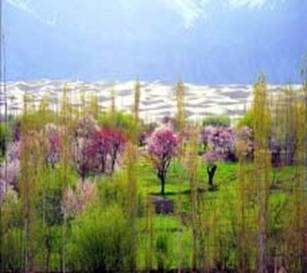 |
After lunch and a brief rest we took off at 1500 hours to explore one of the Valleys east of Skardu connected by a very narrow orge. Unfortunately we had to turn back half way due to severe turbulence. This was our first experience of such turbulence, even with full power we could not maintain height of more than 500 feet agl. It was a testimony to the fact that down drafts unless very severe(more on that later) don’t go all the way to the ground level. The way Our Star Streak performed, reinforced our confidence in its rough weather handling and structural integrity. We returned to Skardu and for the next 2 hours explored its extremities, landing before the airport closed for the day.A very satisfying day indeed.
27th August (Glasier). We planned to take off very early to exploit better climb performance in the thin but cool morning air. However we were delayed until 10 am by a helicopter, which was also flying to Baltoro glacier and could assist us in case of emergency. Today we carried a small bottle of oxygen for flying at high altitude. The OAT(outside air temp) at the airport read 32 degrees C resultantly,with the density altitude of over 11000 feet the take off roll was unusually long. The Star Streak painfully climbed in the thin hot air. After a brief flight eastwards over Indus river we turned north east into the Shigar valley, a comparatively narrower but longer valley (5 miles wide and 30 miles long), more picturesque compared to Skardu. We tried and to some extent found lift on the sun baked slopes.
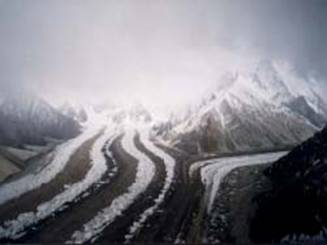 |
Near end of the valley the route to Baltoro glacier takes an abrupt right turn through the extremely narrow and precipitous Braldu gorge. The sheer scale of the gorge certainly dwarfs the grand canyon. The air was not very turbulent however on occasional up and drawn draft reminded us that, after all, these are Karakorams! In an unforgiving terrain like this, there is not much that one can do in case of emergency so it becomes needless looking for a force landing spot.
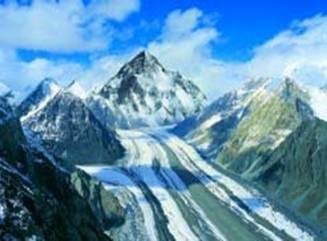 |
A ballistic parachute would have been very comforting. One hour later at 14500 feet we were over the Baltoro glacier. Low clouds blocked the route to K-2 base camp. We had to content our selves with flying around the highest granite towers in world the Trango towers and Grand Cathedral group (all over 21000 feet ). It is a magnificent sight: the Baltoro glacier a massive river of Ice and strewn rocks with Paiyu peak (21000 ft) guarding its mouth followed by Trango Towers and Grand Cathedral further up on the left and on the right side one could barely make out the Masherbrum Massif (25659 feet ) its summit hidden by clouds. A renowned photographer Galen Rowell calls it “The Throne Room of Mountain GODS”.
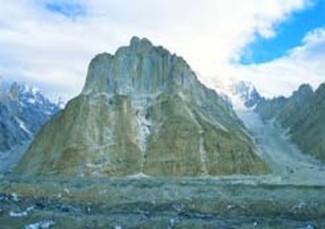 |
Soon we felt the wind picking up,the turbulence increasing with every passing minute. On the way back we struggled to maintain height in the constant downdrafts. We got uncomfortably low over the last village of Ashkole, many brightly coloured tents of tourists dotted the fields around it. Many a times we had to circle in up drafts before crossing the sinkholes. The air suddenly got calm as we exited the Braldu gorge and entered Shigar valley. Landing at Skardu was eventful. After a smooth initial touch down the aircraft veered sharply to the left before coming to a grinding halt. Bhangoo remarked “Its the cross wind”. Getting out we found the left tire flat (problematic Nylon hubs). Bhangoo upon seeing the flat tire fished for compliments on his smooth landing, but Ajab put a damper on it, laughingly remarking “you said it was the cross wind!!” We sent for finding a suitable auto jack to lift the wheel. However in the mean time to quickly clear the runway we manually lifted the wheel, put it on a creeper and viola! pushed it to the hangar desi style. Flight of the day was 2 hours 20 minutes. Disappointed that we could not make it to K-2 base camp we nevertheless considered it to be a very interesting and useful flight.
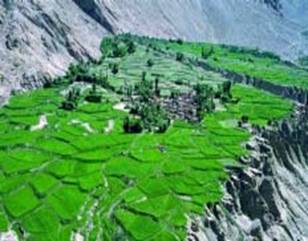 |
28th August (To Gilgit). Woke up to a beautifully clear day, said a quick goodbye to our friends and at 0730 hours we were weaving through the Indus gorge westwards towards Gilgit 100 miles away. The morning air was fairly smooth and we enjoyed the
spectacular flight with a superb view of
Mount Haramosh (24537 feet). Weaving and twisting through the gorge was perhaps more thrilling than the air races at Reno-Nevada! Reached Gilgit (OPGT) after 1 hour and 10 minutes. Gilgit is the last big town before the Chinese border on the Karakoram highway. A larger and bustling town compared to the idyllic and still primitive Skardu.The valley is narrow and the barren mountains make's it a perfect heat radiator. Temperatures regularly rise to 40 degs C at midday during summers. We secured the Star Streak for the day by parking fire tenders around it as windbreakers, in the evening here, winds roar like an express train. Next morning was to be a challenging attempt at Khunjerab pass 15500 feet on Pakistan—China border.
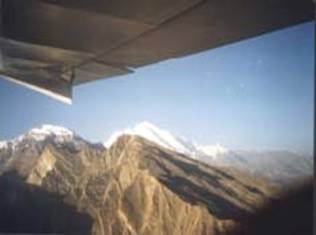 |
29th August (Khunjerab Pass). Took off early at 0530 hours with approx 65 liters of fuel. We flew along the western slopes of mount
Rakaposhi (25551 feet) resembling a giant sleeping beauty, its summit lit golden by the rising sun. The Star Streak climbed satisfactorily : Below in the famous Hunza valley on our left under another grand mountain the Ultar peak (24045 feet) we could spot the 600 years old Baltit fort perched on an outcrop. By now the sun was high enough to bathe the entire valley with its golden rays. Crossing 12000 feet we left Hunza valley behind us and Khunjerab was now 45 minutes away. Suddenly over the hamlet of Passu we felt the engine briefly splutter. Immediately we noticed the fuel pressure dropping to zero. To further investigate the problem we reduced power and decided to circle over Passu which luckily offered a good force landing site along the road. The fuel pressure stayed at zero and the engine would splutter once the power was increased beyond 4800 RPM. Bhangoo suggested a force landing, but Ajab preferred trying to get back to Gilgit if the fuel pressure remained steady. We circled for 15 minutes over Passu slowly gaining height for safety incase the engine quit. The flight back to Gilgit was a test of nerves, both of us maintaining a keen lookout for a force landing site (that never appeared) and our ears were tuned to the steady drone of the engine. 20 minutes short of Gilgit, Bhangoo remarked “we better break the silence and talk”, Ajab however snapped “I’d rather concentrate on the terrain we will have plenty of time later”. Finally to our great relief the hill that marks the undershoot of the runway at Gilgit came into the distant
view.
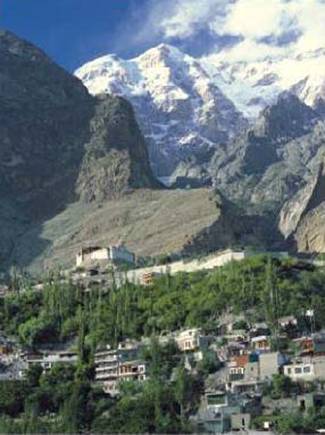 |
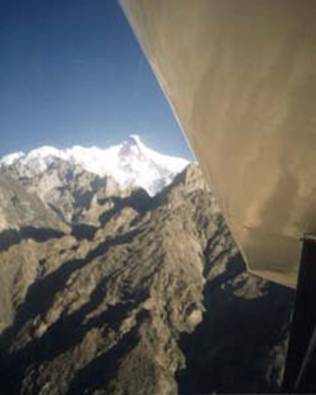 |
By this time the fuel pressure had dropped to minus 2 but miraculously the trusty rotax maintained a steady drone. A quick landing ,the engine finally quitting on touchdown when brought to idle. How good it felt to be back on Terra Firma! The last 1 hour 45 minutes had been tense. We quietly without ado pushed the Star Streak off the runway and sat down in the shade of the trees for a much needed rest and tea ! As suspected, the fuel filter had clogged due to dirty fuel despite the fact that “Mr. Funnel” had always been used. A trip to the market and we found a Toyota fuel filter. It appeared to work fine however the fuel pressure stayed at 2 psi. We were not taking any chances. We had a few spare brass mesh filters at Islamabad which were shipped by the scheduled flight next morning.
30th August. After a short test flight in the morning to check the fuel filter, we fueled up for the return flight to Islamabad. Take off was delayed till 1200 hours due to a flat nose wheel and unscheduled traffic in the one way Indus gorge. The heat was getting uncomfortable, OAT read 39 derees C. Despite our considerable experience in mountain flying and the fact that Indus river gorge is notorious for turbulence at midday in summers, we took the risk much to our repentance. Weather was clear but turbulent, fuel pressure an assuring 5-psi. Another rule we violated was flying low in the gorge , that was unavoidable due to the hot air and frequent down drafts. 1 hour 30 minutes into the flight just short of Dassu we encountered the most terrifying and violent turbulence. The Star Streak was thrown all over, at one point our ground speed dropped from 85 mph to 50 mph experiencing both negative and positive G’s in the up and down drafts well in excess of 1000 ft per minute. Bhangoo, who was flying, struggled to keep the Star Streak from falling out of the sky at barely 150 feet above the river with at times the Karakoram highway looming above us. Here the gorge is perhaps as narrow as 300-400 yards across and even with the rotax 912S (100 HP) straining at full throttle to avoid crashing in the menacing torrents below, the Star Streak refused to climb. Just when we briefly rose in an updraft above the Karakoram highway, Bhangoo broke the silence and suggested force landing on the road as it offered a better chance of survival verses certain death in case of crashing in the river. Ajab, as usual optimistic, preferred trying to get back to Gilgit. In any case if we did attempt a force landing, after which perhaps the Star Streak wouldn’t look more than a CANOE at best !! that was something we both couldn’t bear to happen . Bhangoo handled the Star Streak beautifully and managed two wobbly 360’s turn in the omni directional wind while Ajab lowered the flaps to arrest the descent, finally headed back towards Gilgit.
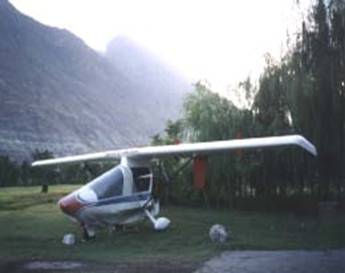 |
Gilgit Airport
100 feet below us all vehicles on the road stopped, perhaps to witness an imminent crash (much to their dismay) as we struggled. We flew back at 5500 RPM (max continuous permitted) 400 feet above the road barely climbing, but at least out of the hellhole. The
fuel pressure and engine temperature remained reassuringly in green. We reached Chilas 30 minutes later at almost 800 agl, the climb improved as we encountered some updrafts. The valley here, was comfortably wider and possible crash landing sites in abundance !! Strong headwind reduced our ground speed, overtaking vehicles below on the road at a snail’s pace. Near Jaglot we spotted a pair of tourist cyclists laboriously pedaling whom to our amusement and perhaps to their encouragement were overtaken in almost slow motion. Alast Gilgit came into view and we landed after being 3 1/2 hours in the air. After quietly securing the Star Streak we once again retreated in the shade of the trees, breathing a sigh of relief after the wildest flying experience. Perhaps GOD wanted us to live. Bhangoo remarked, that in his almost 6500 hours flying (most of it in the mountains) this was one of the worst.
Slowly sipping the badly needed invigorating tea we wandered in our thoughts over the events of the last 3 1/2 hours. It felt good to have experienced such turbulence and yet be alive to tell the story. “One would rather be on ground than wishing to be on ground”.
31st August. Mindful of the previous day’s experience we rose early and took off at 7 am. The air was wonderfully smooth after the early morning rain and as we flew past the place where we had the encounter with the turbulence, how benign it looked today! 3 1/2 hours later landed back at Islamabad. In total we had flown 20 hours covering some 1600 miles since we left Islamabad on 26 August. It was an experience of a lifetime in every sense. We had gone places in a microlight where no single engine general aviation aircraft had flown before.
Prologue. As we look back at the experience, it certainly was soul stirring and an extremely satisfying one. Certain important lessons that we want to share regarding flying in mountains as rugged as the Karakorams .
One. Never fly after 10 am especially in summers when temperatures are high.
Two. Be fully familiar with your’s and the aircrafts rough weather handling.
Three. Always have sufficient fuel for a return flight to the base from any point enroute or to reach an alternative airfield, if available.
Four. Fly high in the valleys to avoid amplified mechanical turbulence and venturi effect lower down. Always expect turbulence near confluence of small lateral valleys with the main valley. One must develop the ability to sense winds in the mountain, if you can do it correctly you are a winner.
Five. The aircraft must have adequate reserve power for good take off and climb performance. In the encounter with turbulence on 30th August, perhaps Bhangoo’s experience and the extra 20 hp of rotax 912S saved us .
Six. Always treat fuel from petrol pumps in remote areas with suspicion. So filter twice for water and suspended particles .Use transparent wire mesh fuel filter instead of one with paper element. It would be unfair not to comment on the outstanding performance of the Shadow Star Streak .Its handling in turbulence is as Bhangoo remarks ” legendary” and if on 30th August we were flying any other aircraft we would have certainly crashed. Both Bhangoo and Ajab have experience in flying other similar aircraft i.e. Rans Coyote S6, Zodiac 6O1HD, Club Pelican, Flightstar. Without prejudice the Shadow has no equal when it comes to high altitude performance and handling in turbulence. No adventure comes without its life threatening hazards. So before going ahead, prepare for the worst and hope for the best. Lastly, don’t make it a habit.
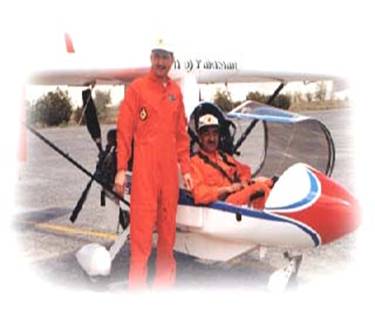 |
AJAB KHAN A pilot since the age of eighteen is amongst the pioneers of ultralight flying in Pakistan and has assembled three ultralight aircrafts. An army officer by profession he pursues flying as a hobby rather than a profession. Happily married with two boisterous sons and a girl, seven , five and one year old. Member USUA Club # 127 & 148 ajab62@yahoo.com
ZAKA ULLAH BHANGOO
Has had an illustrious career as an army aviator where he was the commander of VVIP flight for 8 years. He has over 6500 hours of flying experience on all types of aircrafts. Even after retirement, he is pursuing his passion for flying and has taken on ultralight flying . His daring helicopter rescue operation during the 1992 Neelum Valley floods was featured in Reader's Digest (July 1994) as Drama in Real Life. He is married with three sons, two of whom are in the army. Member USUA Club # 127
Zubhangoo@hotmail.com
PS: Zaka died in a tragic air crash along with Michael Newman (a fellow Shadow owner from Suffolk) near Trabzon Turkey in 2007, while flying an Italian Sky Arrow from the UK to Pakistan.
© Copyright ZAKA ULLAH BHANGOO and AJAB KHAN 2010
Video footage of the earlier exploration of the far reaches of the Karakoram Mountain Range referred to earlier in the article above. August 2001.